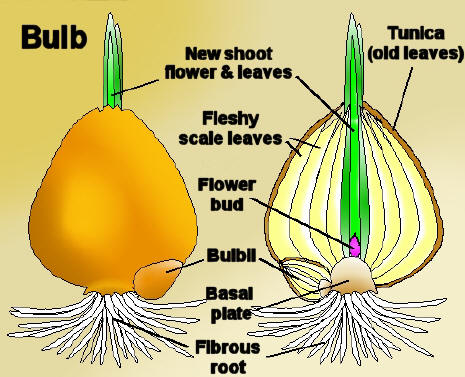| |
|
|
| |
A thick, rounded,
underground
storage organ
consisting of layered,
fleshy
leaves and
membranes. |
|
| |
|
|
 |
A
bulb is an
underground
stem, usually
globular, containing a complete
embryonic
plant inside, with
tiny
flowers,
stems,
leaves, and
roots. The contents of
the bulb are often enclosed in protective, fleshy
scales emerging from
the top which are held together by a small
basal plate. The scales are
modified leaves that contain enough nutrients to sustain the
plant through
dormancy and early
growth. The
fleshy leaves are
storage organ
that store
food and
water, they may be
loose and open. In many bulbs, a paper-thin
tunic protects the
scales.
Fibrous roots emerging from the bulb's basal plate. Examples
include the tulip, narcissus, and onion. |
During the
growing season; the upper part of the plant dies as the
weather becomes cold or
dry. The bulb remains
dormant (living but inactive) underground until the weather warms
and water is available. At the start of the new growing season, roots
grow from the bottom of the bulb and a bud grows from the stem. The food
and water in the bulb tissues nourish the fast-growing bud. The bud
develops into a plant that will
blossom (producing
seeds above ground)
and then die back (above the ground) at the end of the growing season;
this
cycle
continues year after year. Many bulbs require a period of
low-temperature dormancy before they sprout new buds and roots
Types of Bulbs:
There are two main types of bulbs. One type has a thin paper-like
covering that protects its fleshy leaves (for example, the onion). The
second type, called a scaly bulb, does not have a papery covering and
looks as though it is composed of a group of angular scales (for
example, the true lily). See:
storage organ
|
|
| |
|
|
|